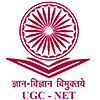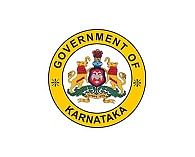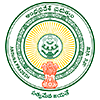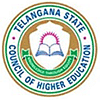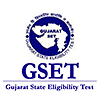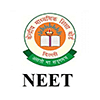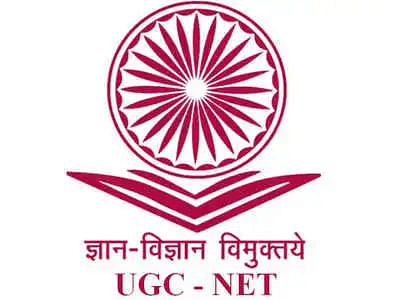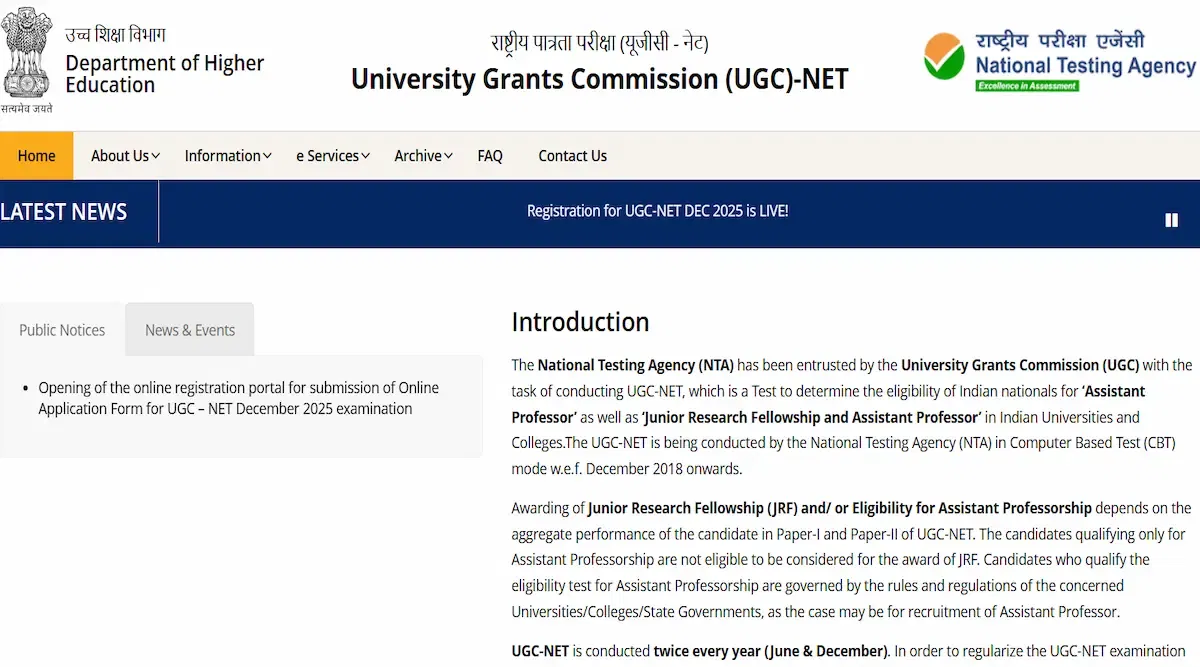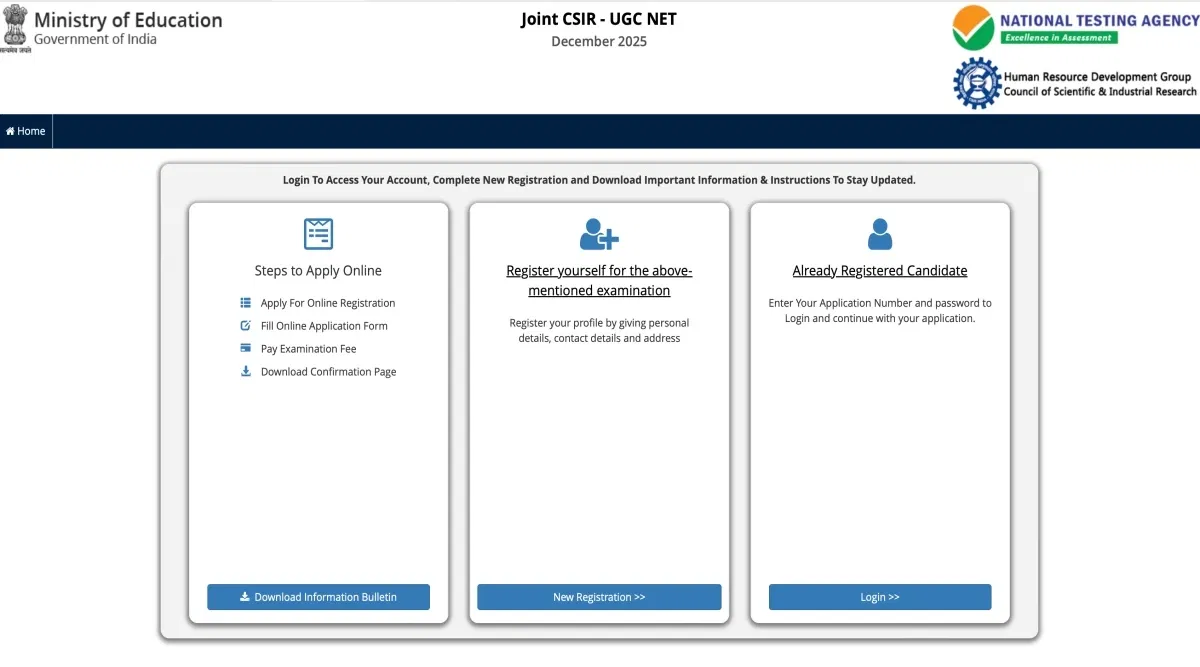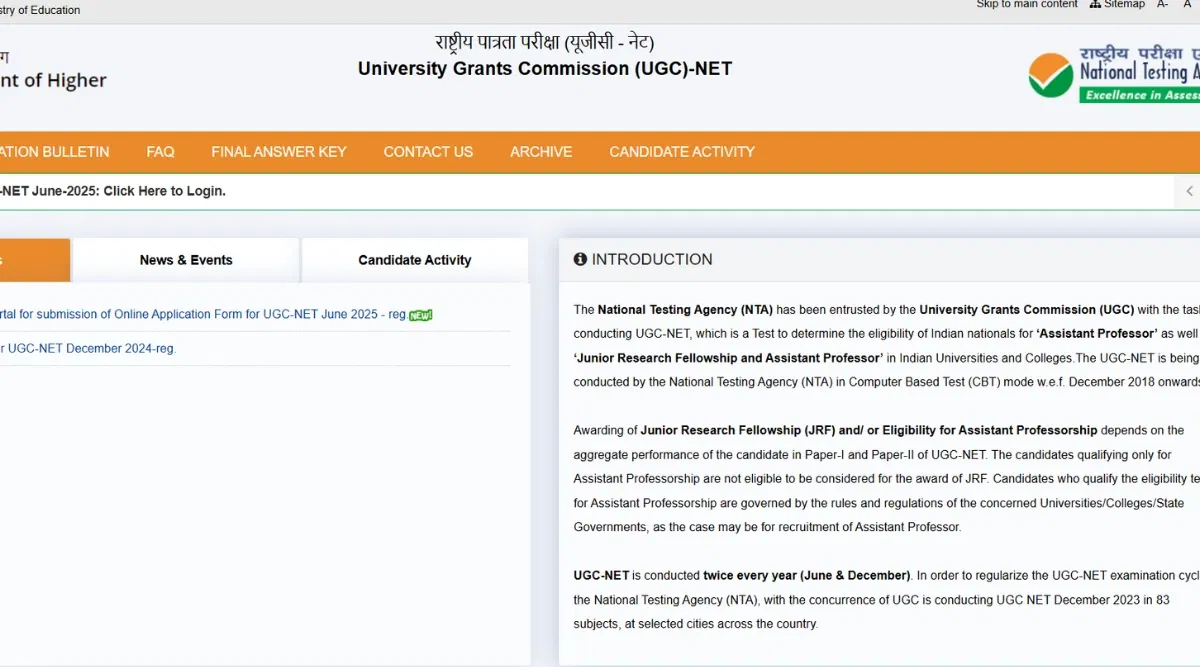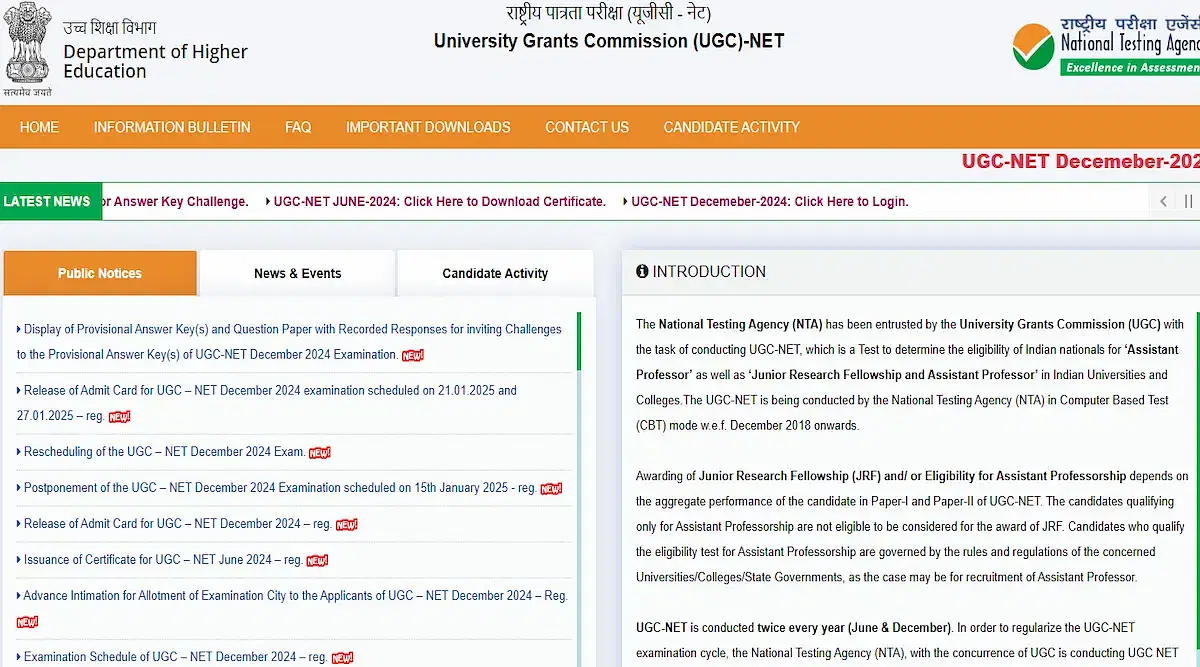
Table of Contents
UGC NET Geography Syllabus 2025 deals with concepts on physical features of the earth and its impacts caused by various activities, which include chapters focusing on Geomorphology, Climatology, Geographic Thought & Techniques, and more.
UGC NET Geography is split into two papers - Paper I and Paper-II. The question papers will have Multiple Choice (MCQs) carrying 2 marks each from a total of 150 questions. The UGC NET Subject code for Geography Syllabus is 80.
The University Grant Commission National Eligibility Test (UGC NET) is a national examination conducted by the National Testing Agency for candidates seeking seats in Lectureship/ JRF across Indian colleges/Universities. It is held two times a year.
UGC NET Geography Syllabus 2025: PDF
UGC NET geography syllabus 2025 pdf link has been provided in the table below for students reference. Applicants must check and download the PDF through the direct link shared.
| Particulars | Link |
| UGC NET Geography Syllabus | Download PDF |
UGC NET Geography Syllabus Chapter-wise
The UGC NET 2025 exam will be conducted in an online mode (Computer Based Test). Let us first understand the exam pattern for the UGC NET Geography syllabus as explained in the following.
- Geomorphology
- Climatology
- Oceanography
- Geography of Environment
- Population and Settlement Geography
- Geography of Economic Activities and Regional Development
- Cultural, Social and Political Geography
- Geographic Thought
- Geographical Techniques
- Geography of India
UNIT-I Geomorphology
The scientific study of the physical features of the earth's surface, occurrence, causes, and its relation to geomorphological structures.
| Topics |
|
| Continental Drift | Geomorphic Cycle (Davis and Penck) |
| Plate Tectonics | Theories and Process of Slope Development |
| Endogenetic and Exogenetic forces | Earth Movements (seismicity, folding, faulting, and vulcanicity) |
| Denudation and Weathering | Landform Occurrence and Causes of Geomorphic Hazards (earthquakes, volcanoes, landslides, and avalanches) |
UNIT–II Climatology
The process of the scientific study of climate including structure and composition, classification, types, evidence, and causes.
| Topics | |
| Composition and Structure of Atmosphere | Insolation, Heat Budget of Earth, Temperature, Pressure and Winds |
| Atmospheric Circulation (air-masses, fronts and upper air circulation, cyclones, and anticyclones (tropical and temperate) | Climatic Classification of Koppen & Thornthwaite |
| ENSO Events (El Nino, La Nina, and Southern Oscillations) | Meteorological Hazards and Disasters (Cyclones, Thunderstorms, Tornadoes, Hailstorms, Heat and Cold waves Drought and Cloudburst, Glacial Lake Outburst (GLOF) |
| Climate Change: Evidence and Causes of Climatic Change in the past | Human impact on Global Climate |
UNIT-III Oceanography
Takes account of the circulation of changes in the oceans, temperature changes, density, salinity, causes of hazards under the study of oceanography.
| Topics | Sub-Topics |
| Relief of Oceans, Composition | Temperature, Density, and Salinity |
| Circulation | Warm and Cold Currents, Waves, Tides, Sea-Level Changes |
| Hazards | Tsunami and Cyclone |
UNIT –IV Geography of Environment
Expands on the components, functions, food web and ecological pyramid, national programmes, policies on the basis of an environment with geography.
| Topics | Sub-Topics |
| Components | Ecosystem (Geographic Classification) and Human Ecology |
| Functions | Trophic Levels, Energy Flows, Cycles (geo-chemical, carbon, nitrogen, and oxygen), Food Chain, Food Web, and Ecological Pyramid, Human Interaction and Impacts, Environmental Ethics and Deep Ecology, Environmental Hazards and Disasters (Global Warming, Urban Heat Island, Atmospheric Pollution, Water Pollution, Land Degradation) |
| National Programmes and Policies | Legal Framework, Environmental Policy, International Treaties, International Programmes and Policies (Brundtland Commission, Kyoto Protocol, Agenda 21, Sustainable Development Goals, Paris Agreement) |
UNIT –V Population and Settlement Geography
Aims on understanding the sources of population data, distribution of world population, settlements in urban and rural, theories and origin of towns, the process of urbanization in developed and underdeveloped countries, the concept of megacities, a manifestation of poverty in the city.
Population Geography
- Sources of population data (census, sample surveys, and vital statistics, data reliability, and errors)
- World Population Distribution (measures, patterns, and determinants)
- World Population Growth (prehistoric to modern period)
- Demographic Transition
- Theories of Population Growth (Malthus, Sadler, and Ricardo)
- Fertility and Mortality Analysis (indices, determinants, and world patterns)
- Migration (types, causes and consequences, and models)
- Population Composition and Characteristics (age, sex, rural-urban, occupational structure and educational levels)
- Population Policies in Developed and Developing Countries
Settlement Geography
- Rural Settlements (types, patterns, and distribution)
- Contemporary Problems of Rural Settlements (rural-urban migration; land-use changes; land acquisition and transactions)
- Theories of Origin of Towns (Gordon Childe, Henri Pirenne, Lewis Mumford)
- Characteristics and Processes of Urbanization in Developed and Developing Countries (factors of urban growth, trends of urbanisation, size, structure, and functions of urban areas)
- Urban Systems ( the law of the primate city and rank-size rule)
- Central Place Theories (Christaller and Losch)
- Internal Structure of the City
- Models of Urban Land Use (Burgess, Harris and Ullman, and Hoyt)
- Concepts of Megacities
- Global Cities and Edge Cities
- Changing Urban Forms (peri-urban areas, rural-urban fringe, suburban, ring and satellite towns)
- Social Segregation in the City
- Urban Social Area Analysis
- Manifestation of Poverty in the City (slums, informal sector growth, crime, and social exclusion).
Unit –VI: Geography of Economic Activities and Regional Development
The chapters deal with the factors, theories, models, typology, classification of the geography of Economic, agricultural, industrial, regional development, the geography of transport, and trade in India.
| Topics | Sub-Topics |
| Economic Geography | Factors affecting the spatial organisation of economic activities (primary, secondary, tertiary, and quaternary), Natural Resources (classification, distribution, and associated problems), Natural Resources Management. World Energy Crises in Developed and Developing Countries. |
| Agricultural Geography | Land capability classification and Land Use Planning, Cropping Pattern: Methods of delineating crop combination regions (Weaver, Doi, and Rafiullah), Crop diversification, Von Thunen’s Model of Land Use Planning. Measurement and Determinants of Agricultural Productivity, Regional variations in Agricultural Productivity, Agricultural Systems of the World. |
| Industrial Geography | Classification of Industries, Factors of Industrial Location; Theories of Industrial Location (A. Weber, E. M. Hoover, August Losch, A. Pred, and D. M. Smith). World Industrial Regions, Impact of Globalisation on the manufacturing sector in Less Developed Countries, Tourism Industry, World distribution and growth of Information And Communication Technology (ICT) and Knowledge Production (Education and R & D) Industries. |
| Geography of Transport and Trade | Theories and Models of spatial interaction (Edward Ullman and M. E. Hurst) Measures and Indices of connectivity and accessibility; Spatial Flow Models: Gravity Model and its variants, World Trade Organisation, Globalisation and Liberalisation, and World Trade Patterns. Problems and Prospects of Inter and Intra Regional Cooperation and Trade. |
| Regional Development | Typology of Regions, Formal and Fictional Regions, World Regional Disparities, Theories of Regional Development(Albert O. Hirschman, Gunnar Myrdal, John Friedman, Dependency theory of Underdevelopment, Global Economic Blocks, Regional Development and Social Movements in India. |
Unit – VII: Cultural, Social and Political Geography
Emphasizes cultural, social, and political means of geographical studies. From the concepts of culture and its complexes, heritage, convergence to boundaries and frontiers, trends and developments, and others across the Indian region.
| Topics | Sub-Topics |
| Cultural and Social Geography | Concept of Culture, Cultural Complexes, Areas and Region, Cultural Heritage, Cultural Ecology. Cultural Convergence, Social Structure and Processes, Social Well-being and Quality of Life, Social Exclusion, Spatial distribution of social groups in India (Tribe, Caste, Religion, and Language), Environment and Human Health, Diseases Ecology, Nutritional Status (etiological conditions, classification and spatial and seasonal distributional patterns with special reference to India) Health Care Planning and Policies in India, Medical Tourism in India. |
| Political Geography | Boundaries and Frontiers (with special reference to India), Heartland and Rimland Theories. Trends and Developments in Political Geography, Geography of Federalism, Electoral Reforms in India, Determinants of Electoral Behaviour, Geopolitics of Climate Change, Geopolitics of World Resources, Geopolitics of Indian Ocean, Regional Organisations of Cooperation (SAARC, ASEAN, OPEC, EU). Neopolitics of World Natural Resources. |
Unit VIII: Geographic Thought
Emphases on covering the contribution of Geographers, contributions of Greek, Arab, Chinese, Roman, and Indian Scholars. Ideas and theories involved with geographical traditions, studies, and perspectives on geography dualisms.
- Contributions of Greek, Roman, Arab, Chinese and Indian Scholar.
- Contributions of Geographers (Bernhardus Varenius, Immanuel Kant, Alexander von Humboldt, Carl Ritter, Scheafer & Hartshorne)
- Impact of Darwinian Theory on Geographical Thought.
- Contemporary trends in Indian Geography: Cartography, Thematic and Methodological contributions.
- Major Geographic Traditions (Earth Science, man environment relationship, area studies, and spatial analysis)
- Dualisms in Geographic Studies (physical vs. human, regional vs. systematic, qualitative vs. quantitative, ideographic vs. nomothetic)
- Paradigm Shift
- Perspectives in Geography (Positivism, Behaviouralism, Humanism, Structuralism, Feminism, and Postmodernism).
Unit IX: Geographical Techniques
The techniques on geographical regions like sources of information, data, ma representation, digital image processing, measurement, morphometric analysis, and so on with the highlighted topics in the following.
- Sources of Geographic Information and Data (spatial and non-spatial)
- Types of Maps
- Techniques of Map Making (Choropleth, Isarithmic, Dasymetric, Chorochromatic, Flow Maps)
- Data Representation on Maps (Pie diagrams, Bar diagrams, and Line Graph
- GIS Database (raster and vector data formats and attribute data formats)
- Functions of GIS (conversion, editing, and analysis)
- Digital Elevation Model (DEM)
- Georeferencing (coordinate system and map projections and Datum)
- GIS Applications ( thematic cartography, spatial decision support system)
- Basics of Remote Sensing (Electromagnetic Spectrum, Sensors and Platforms, Resolution and Types
- Elements of Air Photo and Satellite Image Interpretation and Photogrammetry)
- Types of Aerial Photographs.
- Digital Image Processing: Developments in Remote Sensing Technology and Big Data Sharing and its applications in Natural Resources Management in India
- GPS Components (space, ground control, and receiver segments) and Applications
- Applications of Measures of Central Tendency
- Dispersion and Inequalities
- Sampling
- Sampling Procedure and Hypothesis Testing (chi-square test, t-test, ANOVA)
- Time Series Analysis, Correlation, and Regression Analysis
- Measurement of Indices
- Making Indicators Scale Free
- Computation of Composite Index
- Principal Component Analysis and Cluster Analysis.
- Morphometric Analysis: Ordering of Streams
- Bifurcation Ratio, Drainage Density, and Drainage Frequency
- Basin Circularity Ratio and Form Factor
- Profiles, Slope Analysis
- Clinographic Curve
- Hypsographic Curve
- Altimetric Frequency Graph.
Unit – X: Geography of India
The last section of the unit mainly focuses on studies on physiographic regions related to their characteristics, types, and distribution of natural resources, accountability, and control.
| Topics | Sub-Topics |
| Major Physiographic Regions and their Characteristics | Drainage System (Himalayan and Peninsular) |
| Climate | Seasonal Weather Characteristics, Climatic Divisions, Indian Monsoon (mechanism and characteristics), Jet Streams and Himalayan Cryosphere |
| Types and Distribution of Natural Resources | Soil, Vegetation, Water, Mineral and Marine Resources. Population Characteristics (spatial patterns of distribution), Growth and Composition (rural-urban, age, sex, occupational, educational, ethnic and religious), Determinants of Population, Population Policies in India, Agriculture ( Production, Productivity, and Yield of Major Food Crops), Major Crop Regions, Regional Variations in Agricultural Development, Environmental, Technological and Institutional Factors affecting Indian Agriculture; Agro-Climatic Zones, Green Revolution, Food Security and Right to Food. Industrial Development since Independence, Industrial Regions and their characteristics, Industrial Policies in India. Development and Patterns of Transport Networks (railways, roadways, waterways, airways, and pipelines), Internal and External Trade (trend, composition and directions), Regional Development Planning in India, Globalisation and its impact on Indian Economy, Natural Disasters in India (Earthquake, Drought, Flood, Cyclone, Tsunami, Himalayan Highland Hazards and Disasters.) |
| Accountability and control | Institutional mechanism for checks and balances, legislative control over the executive, administrative and budgetary control, control through parliamentary committees, judicial control over legislature and executive, administrative culture, corruption, and administrative reforms |
UGC NET Exam Pattern 2025
Candidates appearing for the exam must keep in track with the latest exam pattern:
- Paper I: Evaluate candidate’s skills and eligibility for Teaching and Research Ability
- Paper-II: Questions will be based on the chosen subjects opted by the candidate
| Highlights | UGC NET Paper-I | UGC NET Paper-II |
|---|---|---|
| Test mode | Online | |
| Duration of test | 3 hours (180 minutes) | |
| Paper type | Common | Subject Specific/Preference-based questions |
| Questions type | Multiple Choice Questions (MCQ)s | |
| No of Questions | 50 | 100 |
| Mark in Total | 100 | 200 |
| Marking Scheme | No negative Marking, 2 marks per correct response | |
| Language medium | English & Hindi | |
Note: There will be a continuation of the test with no break/short recess from Paper-I to Paper-II unless emergencies/technical glitches.
Best books for UGC NET 2025 Geography Syllabus
The wisest technique to apply for combatting national exams like NET Exam is to select the right book. Now, the best books are the ones that are well-defined and explained in a simplified manner as per the UGC NET NTA Syllabus under the Geography (subject-specific). We have also gathered the UGC NET reference books that would be handy for the upcoming UGC NET 2025 Exam.
The list below can be taken into account when getting prepared for studying well for UGC Geography, a little step to success is closer!
| Books | Authors |
| Geography Book (6-12) | NCERT |
| UGC NET/SET (JRF & LS) Geography | Shuchi Rastogi (Arihant) |
| NTA UGC NET/JRF/SET Geography Paper-2 | Arihant Experts |
| NTA UGC NET/JRF/SET Geography Paper-2 | Rajiv R Srivastava |
| UGC NET Geography | A. Magon and B.P. Panigrahi (Trueman’s) |
| Geography of India | Dr. Majid Hussain |
| Advanced Economic Geography | Dr. Alka Gautam |
| UGC NET Geography (Paper 2) Exam Guide | Indra Kumar Lal (R Gupta’s) |
| Human Geography | Dr. Majid Hussain |
| Models of Geography | Dr. Majid Hussain |
| Certificate of Physical and Human Geography | Gohcheleong |
| Physical Geography | Savindra Singh |
